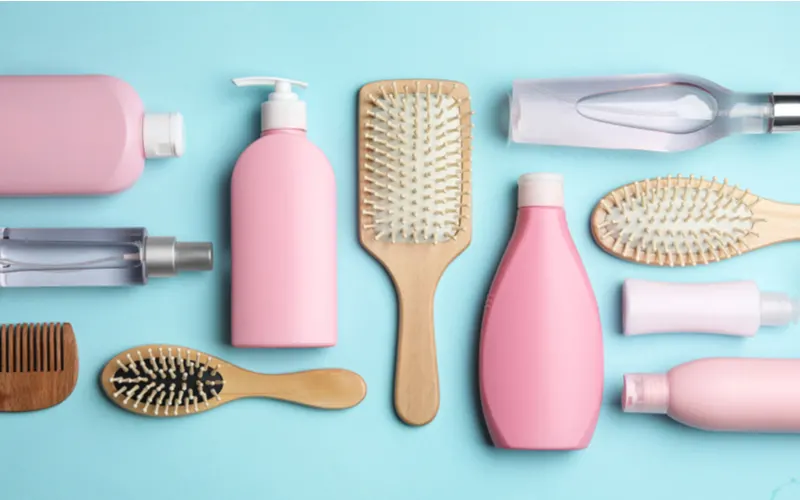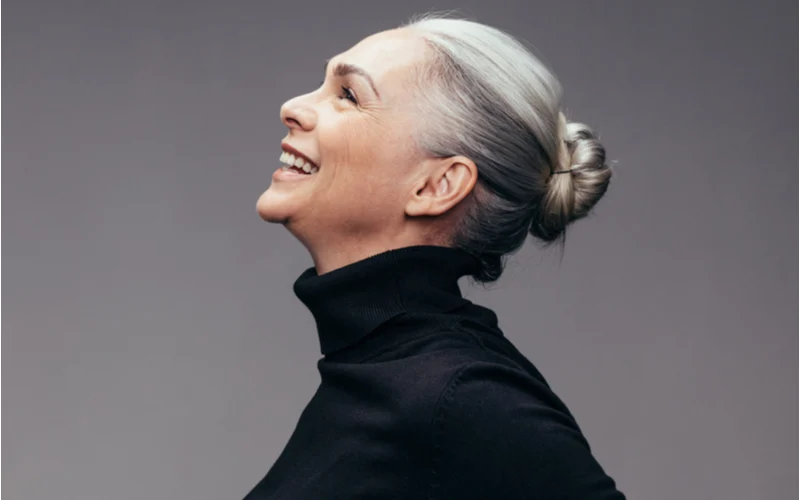Jump to:
Sometimes seemingly overnight, gray hair sneaks unknowingly into our lives. This surprise entrance leaves some horrified and many wondering what to do.
But, there is no need to panic! In this guide, we walk you through everything you need to know when learning what to do about gray hair. It’s easier to get rid of than you think!
What Is Frizzy, Gray Hair?

Nadino/Shutterstock
Frizzy gray hair can catch you looking surprisingly frazzled and off-guard if it is not managed and cared for well. As we age, gray hairs that come in likely include different attributes and characteristics than the hair we had when we were younger.
These pesky, new locks can come with a host of new hair problems and challenges that did not impact us younger in life, including:
- Frizz
- Unmanageable curls
- Coarser texture
- Thinning hair
- Dryness
With these traits, managing gray hair can seem as though you are trying to learn an entirely new sport while playing against an all-star team.
We explore the causes of frizzy gray hair and what you can do about it while also dropping the little details you need to keep your bouffant from going bust.
What Causes Frizzy, Gray Hair?
When we age, pigment cells in our hair follicles die. As a result, our hair doesn’t contain as much melanin when we are older and becomes lighter – grey, silver, or white. Gray hair has some color but is coarser, stiffer, and more difficult to style than darker hair.
Chemical changes within hair fiber’s structure mean that gray hair is more resistant to laser hair removal and is less likely to absorb artificial or temporary colors.
Gray hair can also grow up to four times faster than hair with color and is more sensitive to environmental damage. Dry, frizzy gray hair needs more protection from environmental factors, particularly the sun, than hair that still has pigment.
Best Products to Use for Dry, Frizzy Gray Hair

New Africa/Shutterstock
When faced with a brand new hair challenge, the list of possible solutions can seem just as overwhelming as the original problem.
Separating fact from fiction, and oil from shampoo can seem like a monumental task. Knowing about these products in mind can help you confidently choose the best hair care solutions for the best you.
Read Next: How to Get Rid of Frizzy Hair
Oils
If you’ve never applied hair oil or had a hot oil treatment before, it may be time to treat yourself if you’re battling a shock of renegade gray hair.
Natural oils contain the nutrients and ingredients that dried-out gray hair needs, but they can also help repair damage caused by earlier artificial chemicals and products. Remember that oil repels water and, consequently, it is best to apply oil-based products to dry hair.
Argan, coconut, almond, jojoba, and olive are some of the oils richest in the hydrating nutrients and ingredients gray frizzy hair craves.
Olive and almond oils include softening emollients that protect and moisturize hair with natural ingredients. Look at the ingredients in these and other carrier oils and choose a variety rich in the essential, moisturizing vitamins and fatty acids your hair needs.
Read Next: What Oil Is Best for Your Hair?
Shampoos
Over time, gray hair accumulates toxins caused by pollution, hair product build-up, and environmental damage. These pollutants can cause it to turn yellow or even take on a blue tint in some circumstances.
To minimize this effect, look for brass-fighting shampoos that are often purple to neutralize the impact of yellow tones and keep your hair looking light and silvery. Also called clarifying shampoos, these products help purge your hair of the toxins that build up over time.
Sometimes these shampoos target brassiness in general, which can apply to blonde hair, instead of limiting their potential market to gray hair specifically. The best shampoo products for frizzy gray hair are those that clarify and remove toxins while hydrating the hair to improve its changing chemical composition.
Read Next: Best Shampoo for Gray Hair
Conditioners
Like its counterpart shampoos, anti-brass conditioners also work well to combat any yellow hues. However, conditioners more often aim to provide added moisture to your gray hair to help combat any frizzy or flyaway texture due to decreased oil production.
If you begin to see gray hairs appear, look for conditioners that use a silk protein.
When your grays are just coming in, you likely do not need a moisturizer that is as heavy as when you have a full head of gray hair. Experimenting can be a helpful way to determine which product or combination of products is best suited to your hair.
Masks and Leave-in Conditioners
Introducing conditioning hair masks into your beauty regimen can enrich the dry and frizzy texture of gray hair beyond what shampoos and conditioners can do on their own. Look for masks that address the two main challenges for gray hair: dryness and brassiness.
The longer application time for these products allows the nutrients, often including natural oils, to permeate and deeply moisturize your hair. Similarly, leave-in conditioners are thinner and lighter than ordinary or pack conditioners and can help moisturize and detangle your hair.
Consequently, leave-in treatments or conditioners can help manage the frizziness of new gray hair. Be sure to try out the varieties specifically aiming to soften the coarseness of gray hair without weighing it down.
Read Next: What Do Keratin Treatments Do to Gray Hair?
Styling Products
Ensure that you use heat-resistant styling products if you want to use a blow-dryer or flat iron to help smooth your gray hair. These targeted products prevent your styling tools from drying out hair that is already in need of moisture.
Smoothing blowout balms are often in the form of gel creams or cream to oil balms and help manage and seal your hair when styling to limit flyaway strands. Styling tools, including brushes, also play a significant role in helping to manage frizzy gray hair.
Choose brushes with natural bristles that disperse the natural oils of your hair but which don’t create too much tension as that can cause further damage to your hair.
If using a flat iron, look for one with ceramic plates. While these straighteners may be a little more costly, they limit damage to your hair and prevent it from further drying out during the straightening process.
Read Next: How to Cover Gray Roots Between Salon Visits
How to Prevent Frizzy, Gray Hair
Fortunately, frizzy gray hair isn’t inevitable. There are several lifestyle factors, including diet and nutrition, that can help prevent your hair from drying out and going gray in the first place.
Nutrition
Water is the best source of moisture for your body, and your hair is no different. Staying hydrated helps your hair stay moisturized and prevents problems like dandruff or an itchy scalp. Since grey hair contains less moisture than pigmented hair, it is even more essential that you are fully hydrated.
Not only does nutrition affect your hair’s texture, but a poor diet or lack of nutrition can contribute to premature graying in the first place. Studies have shown that deficiencies in nutrients such as calcium, Vitamin B, and iron can impact or speed up early onset graying.
Read Next: What Vitamin Is Good for Your Hair?
Stress Management
Physicological stress can cause several conditions that, in turn, impact the texture and color of your hair. The most common example of this is Telogen effluvium which causes your body to temporarily lose significant amounts of hair following severe stress or a traumatic event.
Until recently, many studies were inconclusive about the impact of stress on the premature growth of gray hair. However, a new study has shown that stress, namely the flight or fight response, plays a key role in hair pigmentation.
Physiological stress limits the production of pigment, which, in turn, releases chemicals into the hair follicle. If you can reduce the stress in your life in the first place, controlling any flyway gray hairs will be just one of many positive knock-on effects.
Smoking
Smoking can significantly affect the onset of grey hair before the age of thirty. Studies consistently demonstrate that smokers go gray earlier in life as free radicals emitted when you smoke damage the melanin cells that give hair its color.
Exposure to the other chemicals found in cigarettes also can cause brittle and thinning hair due to their negative impacts on the circulatory system.
Frequently Asked Questions

Jacob Lund/Shutterstock
Aside from wondering what to do about frizzy gray hair, you probably have a long list of specific questions to tackle the nitty-gritty of your haircare needs. These commonly asked questions cover the ins and outs of hair care for the stubborn grays that just don’t quit.
Why is my gray hair coming in curly?
As we age, not only do pigment cells in hair follicles die, but we produce less oil on our skin and hair. This slowed-down production of skin oils and melanin affects hair’s chemical structure and can give your hair a coarse feeling as it is less oily than before.
How to naturally soften coarse gray hair?
Natural hair dyes, such as Henna, can help color your hair and protect it from sun damage. Indian gooseberry is another colorant that is often mixed with oils, such as coconut or almond oil, and applied to the scalp to moisturize and enrich the hair for a glossy appearance.
What are the best products for frizzy gray hair?
Look for products that aim to hydrate and brighten your hair and counter your scalp’s decreased oil production. Products that will keep your hair strong and sleek include many hydrating ingredients, such as almond oil, argan oil, and Vitamin E.
How to stop gray hair from sticking up?
Products, such as blowout creams or defining balms, can help your gray hair maintain a smoother texture when used with a blow dryer. When your hair is wet, the bonds between the hydrogen and other elements are dissolved so your hair lies flatter and smoother.
Blowing out your hair when it is wet encourages the hydrogen bonds to reform, or dry, in the shape you are styling rather than defaulting to your hair’s natural state.
What hairstyles are best for frizzy gray hair?
If you have dense and coarse gray hair coming in, it is better to cut your hair so that the pieces on top are longer. The weight of the longer length on top allows for easier styling and control. Equally important is to get regular haircuts every six weeks to prevent split ends as grey hair needs more moisture and ends become dry more quickly.
Ready to Get Rid of Your Frizzy, Gray Hair?
Frizzy gray hair can emerge as a natural part of the aging process that leaves your locks in need of a little extra love and nourishment. Whether you are looking for topical treatments or preventative measures to take, there are several approaches to managing your gray that are as unique as it is.
Hopefully, this guide to what to do about frizzy hair equipped you with the knowledge and skills and keep you looking your best and any troublesome grays under control.
